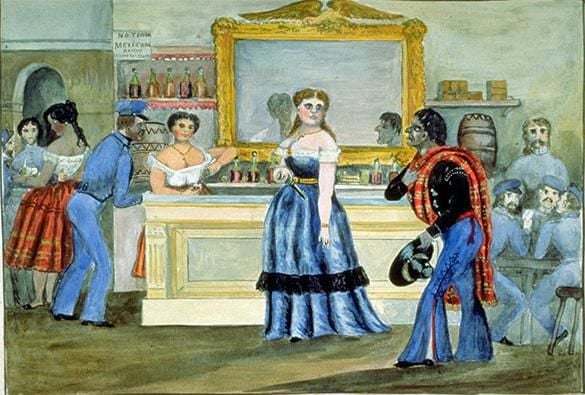Just one thin sheet of sandpaper separated Yuma from Hell, according to Sarah Bowman, a giant of a woman who followed the U.S. Army across Texas and Mexico before settling in that isolated desert spot along the Colorado River.
Over 6 feet tall and weighing 200 pounds, the buxom, red-haired beauty earned the reputation as a hard-working, astute businesswoman even though she could neither read nor write. Toiling as a laundress and cook for the military, her status among the soldiers was one of awe and fear. One of them probably christened her the “Great Western” after one of the largest steam-powered ships to cross the Atlantic Ocean.
Bowman was born sometime between 1812 and 1817 in either Tennessee or Missouri. Her first foray with the military was in 1846 as a laundress, maybe married to one of Zachary Taylor’s soldiers, as Taylor fought the Mexican army along the Rio Grande River.
People are also reading…
That spring, during the battle at Fort Texas (later Fort Brown), Sarah took her pots and pans and headed to the center of the garrison to set up her kitchen. These boys would not be without strong, hot coffee and a nourishing meal if she had anything to say about it. Allowed to charge for her services, she asked nothing for her meals while the fort was under siege.
For seven days the conflict continued. Sarah requested a musket so she could replace the fallen. “The cannonballs, bullets and shot ... were falling thick and fast around her,” read one report. “She continued to administer to the wants of the wounded and dying; at last the siege became so hot that a bullet passed through her bonnet and another through her bread tray.”
When the smoke cleared, Taylor headed to Matamoros, Mexico, where Bowman set up what became the first of her many restaurants and boarding houses along the military road.
By September, she was in Monterrey with Taylor after surviving a bloody four-day battle to take the town. She opened the American House, which provided all the necessities a battle-scarred soldier could desire: food, liquor and the company of obliging women. When Taylor headed to the town of Saltillo that November, she packed up and moved with him, establishing another American House where one soldier said he “paid $2.50 for my entertainment at the boarding house of the Great Western.”
Some of Taylor’s troops deserted during a particularly bloody battle, with one of the fugitives making his way back to the American Hotel claiming Taylor was going down in defeat. Bowman, who absolutely adored Zachary Taylor, soundly punched the man in the face. “You damned son of a bitch,” she shouted, “there ain’t Mexicans enough in Mexico to whip old Taylor. You just spread that report and I’ll beat you to death.” Those who witnessed the confrontation quickly returned to the battlefield.
The U.S./Mexican War ended in the summer of 1848. With troops headed for California, Bowman asked to go along but was told she could not travel with the military because she was no longer married to a military man.
Bowman jumped on her horse and rode down a line of soldiers, announcing, “Who wants a wife with $15,000, and the biggest leg in Mexico! Come my beauties, don’t all speak at once — who is the lucky man?” A soldier named Davis accepted the offer if a clergyman could be found to make the union official.
It took a while for Bowman to make it to California. In the spring of 1849, she was running a hotel on the north side of the Rio Grande in a small community called Ponce’s Ranch that would later become El Paso.
She showed up in Socorro, New Mexico, in 1850 with five orphaned children. Where the children came from remained a mystery.
By this time, she had also acquired another husband, German-born Albert Bowman. When Bowman was discharged from the Army in 1852, the couple headed for California’s gold fields. They made it as far as Fort Yuma.
She signed on to cook for the officers at Fort Yuma, even though Maj. Samuel Peter Heintzelman, who was in charge of the fort, initially found her objectionable. Heintzelman eventually succumbed to her charms and became one of her staunchest supporters.
When Bowman wanted to start a restaurant across the river in Sonora, Heintzelman helped her make the move, although he wrote in his journal, “I can’t see what she expects to do for a living when she moves over there.”
She knew exactly what she was doing. If she stayed at the fort, she would have to abide by Army rules, which hurt her business. Still close enough to the fort for the soldiers to enjoy their free time at Sarah’s place, she offered, as usual, good food, strong whiskey and willing women.
The Bowmans left Yuma in the fall of 1856 to open a boarding house in Tucson. By the following spring, however, Sarah, whose trade depended on the military, had moved her business near Fort Buchanan.
By 1860, she was back in Yuma.
On June 30, 1854, when the Gadsden Treaty was ratified by Congress, it brought 45,000 acres of land into what was then New Mexico Territory. In 1863, when Arizona became a separate territory, Sarah became the first Anglo woman to run a business in the town of Yuma.
Sarah was probably in her early 50s when she died on Dec. 23, 1866. She was the only woman ever buried in Fort Yuma Cemetery. In 1890, the 159 remains of those who had been buried in the old Yuma cemetery were reinterred at the National Cemetery Presidio in San Francisco.
Jan Cleere is the author of several historical nonfiction books about the early people of the Southwest. Email her at Jan@JanCleere.com












